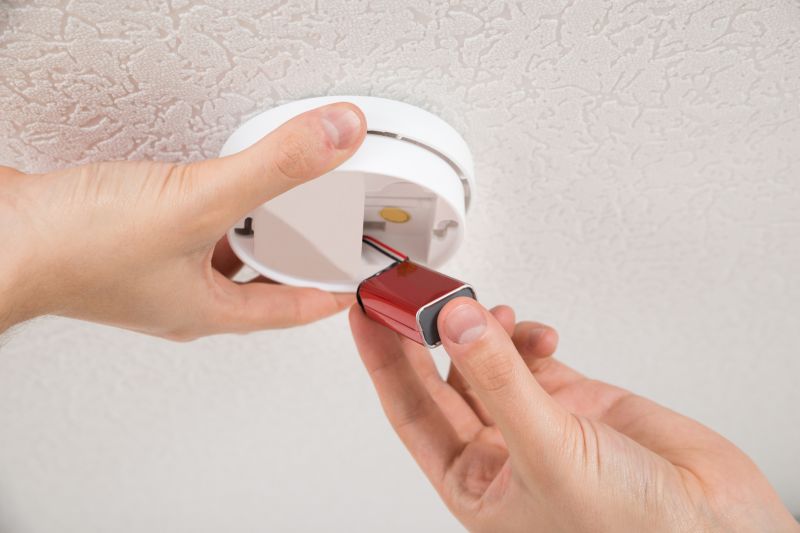Essential Products For Smoke Detector Replacements To Safeguard Your Home
Select from essential replacement devices that ensure continuous protection and compliance with safety regulations.
 Replacing smoke detectors is an essential maintenance task to ensure safety and proper functionality within residential and commercial spaces. When considering replacements, it is important to understand the variety of products available to suit different needs and preferences. Smoke detectors come in various forms, including battery-operated units, hardwired systems, and combination models that incorporate additional features such as carbon monoxide detection or smart connectivity. Selecting the right type involves evaluating the installation environment, desired features, and compatibility with existing electrical systems. Regular replacement of outdated or malfunctioning detectors can help maintain safety standards and ensure early detection of smoke or fire hazards.
Replacing smoke detectors is an essential maintenance task to ensure safety and proper functionality within residential and commercial spaces. When considering replacements, it is important to understand the variety of products available to suit different needs and preferences. Smoke detectors come in various forms, including battery-operated units, hardwired systems, and combination models that incorporate additional features such as carbon monoxide detection or smart connectivity. Selecting the right type involves evaluating the installation environment, desired features, and compatibility with existing electrical systems. Regular replacement of outdated or malfunctioning detectors can help maintain safety standards and ensure early detection of smoke or fire hazards.
Top Overall Option
Multi-Function Smoke Detector
A versatile smoke detector that combines smoke detection with additional features such as carbon monoxide sensing and smart connectivity. Designed for easy installation and maintenance, it offers reliable performance and can be integrated into existing home safety systems. Its long-lasting battery life and user-friendly interface make it a practical choice for various environments.
Types of Products For Smoke Detector Replacements
Battery-Operated Smoke Detectors
Portable units powered solely by batteries, suitable for areas where wiring is not feasible or for temporary setups.
Hardwired Smoke Detectors
Connected directly to the building's electrical system, often with battery backup, ideal for permanent installations.
Combination Smoke and Carbon Monoxide Detectors
Dual-function units that detect both smoke and carbon monoxide, providing comprehensive safety coverage.
Smart Smoke Detectors
Connected to home Wi-Fi networks, offering remote alerts and integration with smart home systems.
Wireless Interconnected Detectors
Units that communicate wirelessly to sound alarms simultaneously across multiple locations.
Ceiling-Mounted Detectors
Designed specifically for ceiling installation, suitable for open areas with high ceilings.
Wall-Mounted Detectors
Ideal for rooms where ceiling mounting is not possible, installed at recommended wall height.
Photoelectric Smoke Detectors
Use light sensors to detect smoke particles, effective for smoldering fires.
Ionization Smoke Detectors
Employ ionization chambers to detect fast-flaming fires, often more responsive to certain types of smoke.
Long-Life Battery Detectors
Feature batteries designed to last several years, reducing the frequency of replacements.
Voice Alert Detectors
Emit voice alerts to specify the type of hazard detected, aiding in quick response.
Hidden or Discreet Detectors
Designed to blend seamlessly into decor while providing reliable detection.
Popular Choices
Popular for their ability to connect multiple units wirelessly, ensuring comprehensive coverage.
Favored for their remote monitoring capabilities and integration with smart home systems.
Commonly chosen for their dual detection features, providing convenience and safety.
Preferred for their extended battery life, reducing maintenance frequency.
Often selected for their sensitivity to smoldering fires and low false alarm rates.
Popular for detecting fast-flaming fires quickly and reliably.
Commonly installed in open spaces to maximize detection coverage.
Chosen for their ease of installation in locations without wiring access.
Increasing in popularity for their clear hazard notifications and ease of understanding.
Trending for their ability to send alerts directly to smartphones and connect with other smart devices.
Modern smoke detectors often include features like long-life batteries, easy installation mechanisms, and user-friendly interfaces. Some models are designed for specific locations, such as ceiling-mounted units for open spaces or wall-mounted detectors for areas with limited ceiling access. Additionally, many detectors now offer interconnected systems that activate simultaneously when one unit detects smoke, providing enhanced safety coverage. When choosing a replacement, it is also advisable to consider maintenance requirements, such as ease of cleaning and testing, to ensure ongoing reliable operation.
Investing in quality smoke detectors can contribute to a safer environment by providing timely alerts and reducing false alarms. It is recommended to follow manufacturer guidelines for installation and maintenance, including periodic testing and battery replacement. With a broad range of options available, consumers can find products tailored to their specific needs, whether for a single-family home, apartment, or commercial property. Proper selection and regular upkeep of smoke detection devices are vital steps in safeguarding property and lives against fire hazards.
Key Buying Considerations
- Compatibility with existing wiring or power sources
- Type of detection technology (photoelectric vs ionization)
- Battery life and ease of replacement
- Additional features such as carbon monoxide detection or smart connectivity
- Ease of installation and maintenance requirements
- Interconnectivity with other detectors for comprehensive coverage
- Audible alarm volume and clarity
- Size and placement options suited to the environment
- Compliance with local safety standards and regulations
- Availability of replacement parts and support
- User interface and ease of testing or silencing alarms
- Design and aesthetics to match interior decor
- Warranty and manufacturer support
- Cost and overall value for features provided
- Long-term reliability and user reviews
This content contains affiliate links. We may earn a commission if you purchase through these links, at no additional cost to you.
